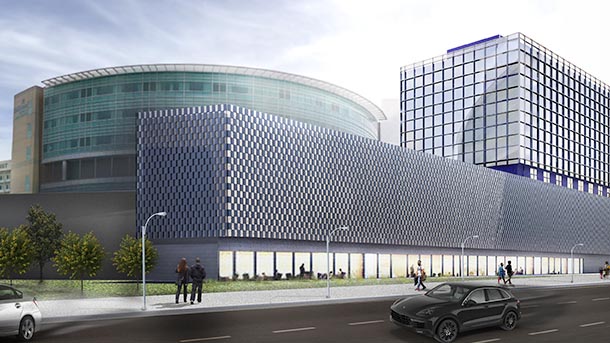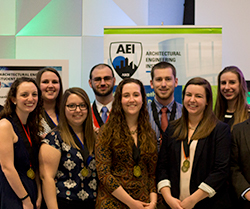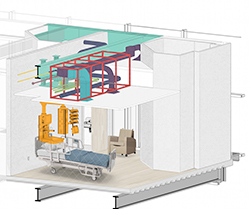
Ten architectural engineering students worked to create a cohesive, adaptable, patient-focused, state-of-the-art children’s hospital rendering for the 2018 Architectural Engineering Institute Student Design Competition.
Building a better health care environment
Architectural engineering students' flexible, integrated children's hospital design honored at national competition
4/19/2018
UNIVERSITY PARK, Pa. — Today’s hospitals must be high-performing, versatile and resilient buildings. They must include innovative and integrated designs, maximizing their ability to serve their occupants’ current and future needs.
As part of the 2018 national Architectural Engineering Institute Student Design Competition, 10 Penn State architectural engineering undergraduate students worked to create a cohesive, adaptable, patient-focused, state-of-the-art children’s hospital located in Omaha, Nebraska.
“Hospitals are perhaps the most inherently challenging building types to construct,” said Ryan Solnosky, assistant teaching professor and lead adviser to the Penn State team. “The only way to achieve state-of-the-art facility demands is for designers to look past a one-system performance approach. They must instead look to the overall performance that the collective group of disciplines generates when working together seamlessly.”
Design challenges included a high-performance and energy-efficient enclosure, a roofing system with helipad capabilities, the use of smart building technologies, and flexible spaces for disaster response.
Fifth-year team members Colleen Aydelotte, Brianna Basile, Tom Campbell, Holly Davia, Camille Stefani, Devon Nguyen, Nicole Stammer, Mary Taylor, and Josh Walker, along with fourth-year student Alex Gubler, focused their design on integration, adaptability, wellness and community.
“A state-of-the-facility is not just defined by the excellence of the building systems; it is defined by the success of the holistic design,” Stefani said.
To fit these ever-changing needs, the team worked to integrate the building’s structure, systems and construction into one seamless project.
“When all architecture, mechanical, electrical, structural and construction teams collaborate from the beginning of the project process, opportunities between disciplines can be identified early on,” Basile said. “This integration allows for innovative, constructible and cost-effective projects [to be built].”
The team’s collaborative and innovative construction, lighting and electrical, mechanical, and structural planning and design created an optimal health care facility, with opportunities for future adaptability.
Construction plans focus on prefabrication factory to improve various building components, a detailed build schedule, a cost-effective design, and a central plant to increase integration and ease of facility management.
Lighting and electrical designs center around RGB + White LED lighting that promotes better circadian rhythm, patient controls, a backup power system that provides 96 hours of emergency power, and microturbines in the building’s central plant to produce steam and power.
Improved mechanical systems involve a combined heat and power system to supplement electrical and thermal systems, a rainwater collection system, patient controls, and a double-skin façade to reduce energy loss and to improve overall building acoustics.
Structurally, the design includes concrete cast-in-place shear walls and an impact resistant façade. Composite framing was used to increase coordination with the mechanical, electrical and plumbing team.
According to Stefani, adaptable health care spaces like the one the team designed are critical due to the longer expected lifespan of these buildings.
“The hospital has to adapt to changes in care on both a day-to-day basis and throughout the life of the building,” she said. “Each patient has different needs and also preferences, and [our] design team wanted to provide a patient space that allows both the medical staff to provided the highest efficiency of care while adapting to each patient.”
After presenting its final design to a panel of judges on April 5, the team received first place in the mechanical, structural and integration categories; second place in the construction category; and was named the recipient of the disaster preparedness innovation award.
“The team’s performance in the competition showcases the technical depth and rigor of our Penn State students, but perhaps, more importantly, it showcases the ability for an architectural engineering student to be both a technical expert and an integrator, something that is highly needed and sought after in our industry,” Solnosky said.



 Patient room designs include improved room acoustics; updated ceiling heights; the installation of a medical boom; prefabricated bathroom pods; improved daylighting capabilities; concrete cast-in-place shear walls; LED lighting and patient controls for lighting, heating and cooling.
Patient room designs include improved room acoustics; updated ceiling heights; the installation of a medical boom; prefabricated bathroom pods; improved daylighting capabilities; concrete cast-in-place shear walls; LED lighting and patient controls for lighting, heating and cooling.
